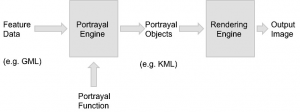ISO 19117:2012 Geographic information - Portrayal
Overview
| Full name | ISO 19117:2012, Geographic information -- Portrayal |
| Version | Edition 2 |
| Amendments | None |
| Corrigenda | None |
| Published by | ISO/TC 211 |
| Languages | English, French |
| Online overview | Not available yet |
| Type of standard | ISO International Standard Meta level |
| Related standard(s) | OpenGIS Styled Layer Descriptor Profile of the Web Map Service Implementation Specification OpenGIS Symbology Encoding Implementation Specification |
| Application | ISO 19117 specifies a conceptual schema for describing symbols, portrayal functions that map geo-spatial features to symbols, and the collection of symbols and portrayal functions into portrayal catalogues. |
| Conformance classes | Portrayal core (general) Portrayal core – symbol Portrayal core – portrayal function Portrayal core – portrayal catalogue Portrayal core plus condition function extension Portrayal core plus context extension Portrayal core plus symbol parameter extension Portrayal core plus compound symbol extension Portrayal core plus complex symbol extension Portrayal core plus reusable symbol component extension Portrayal core plus symbol parameter extension |
Scope
This International Standard specifies a conceptual schema for describing symbols, portrayal functions that map geo-spatial features to symbols, and the collection of symbols and portrayal functions into portrayal catalogues. This conceptual schema can be used in the design of portrayal systems. It allows feature data to be separate from portrayal data, permitting data to be portrayed in a dataset independent manner.
- This International Standard does not address the following:
- standard symbol collection (e.g. International Chart 1 – IHO);
- a standard for symbol graphics (e.g. scalable vector graphics [SVG]);
- portrayal services (e.g. web map service);
- capability for non-visual portrayal (e.g. aural symbology);
- dynamic rendering (e.g. on the fly contouring of tides);
- portrayal finishing rules (e.g. generalization, resolve overprinting, displacement rules);
- 3D symbolization (e.g. simulation modelling).
Implementation benefits
The conceptual schema defined by ISO 19117 allows the development of a portrayal for a specific application field. This schema can be exchanged and implemented in different applications. One of the main benefits of ISO 19117 is that it will allow datasets to be displayed according to some specification without changing or manipulating the original dataset. Portrayal allows the client to create a unique representation for features to communicate an explicit meaning. ISO 19117 can be applied to a variety of products, such as hard copy maps, digital maps, and online representations in a web browser.
Implementation guidelines
Portrayal is the process of presenting information to humans. The portrayal mechanism (as shown in the figure below) makes it possible to portray a single dataset in multiple ways without altering the dataset. Each feature will point to a rule that is applied when the feature is generated on a map, for example.
The conceptual schema described in ISO 19117 is based on UML and follows the guidelines set out in ISO/TS 19103. The schema contains a series of UML packages, defining the portrayal core, and extensions for conditional functions, context, compound symbols, reusable components, parameterised symbols and the portrayal functions that use parameterised symbols. Fundamental to the concept of portrayal is that the symbols and portrayal functions shall be not be part of the dataset.
- The portrayal core package is divided into three sub packages:
- Portrayal Function package
This package is used to define mapping functions. The information to be portrayed shall be defined in an application schema, and all mandatory and conditional (if required) portrayal function elements shall be present in the functions. This package also ensures that elements, which are not being portrayed, are mapped to symbols with no components. - Symbol package
Symbol package is used to define symbols. For the symbol package a default symbol needs to be assigned, and all the mandatory and conditional (if required) symbol elements that shall be present. The core symbol class supports basic symbols, however, one can extend it, for example, with hatch fills or reusable symbols. - Portrayal Catalogue package
The portrayal catalogue package is used to define portrayal catalogues. The portrayal information, such as the feature portrayal functions and applicable symbols shall be present in the portrayal.
- Portrayal Function package
